Xanthium spinosum L. Extracts Inhibit Breast Cancer in Mice by Apoptosis Induction and Immune System Modulation
Abstract
1. Introduction
2. Results
2.1. LC-MS Analysis of X. Spinosum Ethanol Extract
2.2. Antiproliferative Activity of X. spinosum Extract and Fractions
2.3. Apoptotic Activity of X. spinosum Extract and Fractions against EMT6/P Cell Line
2.4. Toxicity Evaluation of X. spinosum Extract and Fractions
2.5. Antitumor Effects of X. spinosum Extract and Fractions on EMT6/P Cells Implanted in Mice
2.6. Effect of X. spinosum Extract and Fractions on Serum Levels of ALT, AST, and Creatinine
2.7. Effect of X. spinosum Extract and Fractions on Lymphocytes Proliferation in the Presence and Absence of Mitogens
2.8. Effect of X. spinosum Extract and Fractions on Phagocytic Activity of Mouse Peritoneal Macrophages
2.9. Effect of X. spinosum Extract and Fractions on the Pinocytic Activity of Mouse Peritoneal Macrophages
2.10. Effect of X. spinosum Extract and Fractions on Cytokines of Murine Splenic Lymphocytes
3. Discussion
4. Materials and Methods
4.1. Plant Collection and Extract and Fractions Preparation
4.2. LC-MS Measurements of X. spinosum Ethanol Extract and Fractions
4.3. Animals
4.4. Cell lines and Cell Culture Conditions
4.5. Anti-Proliferation Assay
4.6. Determination of Apoptosis in EMT6/P Cells
4.7. Acute Toxicity of X. spinosum Extract and Fractions
4.8. Antitumor Activity on Experimental Animals
4.9. Assessment of Kidney and Liver Functions in Mice
4.10. Preparation of Murine Splenocytes
4.11. Lymphocytes Proliferation Assay
4.12. Macrophage Isolation from Peritoneal Fluid
4.13. In Vitro Phagocytic Assay (Nitro Blue Tetrazolium (NBT) Reduction Test
4.14. Determination of Pinocytic Activity Using the Neutral Red Method
4.15. TH1/TH2 Assay
4.16. Statistical Analysis
5. Conclusions
Author Contributions
Funding
Institutional Review Board Statement
Informed Consent Statement
Data Availability Statement
Acknowledgments
Conflicts of Interest
References
- Al-Dimassi, S.; Abou-Antoun, T.; El-Sibai, M. Cancer cell resistance mechanisms: A mini review. Clin. Transl. Oncol. Off. Publ. Fed. Span. Oncol. Soc. Natl. Cancer Inst. Mex. 2014, 16, 511–516. [Google Scholar] [CrossRef] [PubMed]
- Mathers, C.D.; Loncar, D. Projections of global mortality and burden of disease from 2002 to 2030. PLoS Med. 2006, 3, e442. [Google Scholar] [CrossRef]
- Desai, A.G.; Qazi, G.N.; Ganju, R.K.; El-Tamer, M.; Singh, J.; Saxena, A.K.; Bedi, Y.S.; Taneja, S.C.; Bhat, H.K. Medicinal plants and cancer chemoprevention. Curr. Drug Metab. 2008, 9, 581–591. [Google Scholar] [CrossRef] [PubMed]
- Bredel, M. Anticancer drug resistance in primary human brain tumors. Brain Res. Rev. 2001, 35, 161–204. [Google Scholar] [CrossRef]
- Pan, S.-Y.; Zhou, S.-F.; Gao, S.-H.; Yu, Z.-L.; Zhang, S.-F.; Tang, M.-K.; Sun, J.-N.; Ma, D.-L.; Han, Y.-F.; Fong, W.-F. New perspectives on how to discover drugs from herbal medicines: CAM’s outstanding contribution to modern therapeutics. Evid.-Based Complement. Altern. Med. 2013, 2013, 627375. [Google Scholar] [CrossRef]
- Löve, D.; Dansereau, P. Biosystematic studies on Xanthium: Taxonomic appraisal and ecological status. Can. J. Bot. 1959, 37, 173–208. [Google Scholar] [CrossRef]
- Weber, E. Invasive Plant Species of the World: A Reference Guide to Environmental Weeds; CABI: Wallingford, UK, 2017. [Google Scholar]
- Romero, M.; Zanuy, M.; Rosell, E.; Cascante, M.; Piulats, J.; Font-Bardia, M.; Balzarini, J.; De Clerq, E.; Pujol, M.D. Optimization of xanthatin extraction from Xanthium spinosum L. and its cytotoxic, anti-angiogenesis and antiviral properties. Eur. J. Med. Chem. 2015, 90, 491–496. [Google Scholar] [CrossRef]
- Tetik, F.; Civelek, S.; Cakilcioglu, U. Traditional uses of some medicinal plants in Malatya (Turkey). J. Ethnopharmacol. 2013, 146, 331–346. [Google Scholar] [CrossRef]
- Ginesta-Peris, E.; Garcia-Breijo, F.-J.; Primo-Yúfera, E. Antimicrobial activity of xanthatin from Xanthium spinosum L. Lett. Appl. Microbiol. 1994, 18, 206–208. [Google Scholar] [CrossRef]
- Kuo, C.L.; Ho, F.M.; Chang, M.Y.; Prakash, E.; Lin, W.W. Inhibition of lipopolysaccharide-induced inducible nitric oxide synthase and cyclooxygenase-2 gene expression by 5-aminoimidazole-4-carboxamide riboside is independent of AMP-activated protein kinase. J. Cell. Biochem. 2008, 103, 931–940. [Google Scholar] [CrossRef]
- Amin, S.; Barkatullah, H.K. Pharmacology of Xanthium species. A review. J. Phytopharm. 2016, 5, 126–127. [Google Scholar] [CrossRef]
- Khan, M. Traditional Uses of Medicinal Plants Practiced by the Indigenous Communities at Mohmand Agency, FATA, Pakistan. J. Ethnobiol. Ethnomed. 2018, 14, 2. [Google Scholar]
- Salinas, A.; De Ruiz, R.; Ruiz, S. sterols, flavonoids, and sesquiterpenic lactones from Xanthium spinosum (Asteraceae). Acta Farm. Bonaer. 1998, 17, 297–300. [Google Scholar]
- Raman, G.; Park, K.T.; Kim, J.-H.; Park, S. Characteristics of the completed chloroplast genome sequence of Xanthium spinosum: Comparative analyses, identification of mutational hotspots and phylogenetic implications. BMC Genom. 2020, 21, 855. [Google Scholar] [CrossRef] [PubMed]
- Yoon, J.H.; Lim, H.J.; Lee, H.J.; Kim, H.D.; Jeon, R.; Ryu, J.H. Inhibition of lipopolysaccharide-induced inducible nitric oxide synthase and cyclooxygenase-2 expression by xanthanolides isolated from Xanthium strumarium. Bioorgan. Med. Chem. Lett. 2008, 18, 2179–2182. [Google Scholar] [CrossRef] [PubMed]
- Andreani, S.; Paolini, J.; Costa, J.; Muselli, A. Chemical Composition of Essential Oils of Xanthium spinosum L. an Invasive Species of Corsica. Chem. Biodivers. 2017, 14, e1600148. [Google Scholar] [CrossRef]
- McQueen, K.; Gottumukkala, V.; Davies, J.F.; Riedel, B. Perioperative implications of the global cancer epidemic. Curr. Anesthesiol. Rep. 2015, 5, 243–249. [Google Scholar] [CrossRef]
- Domokos, E.; Kursinszki, L.; Kelemen, H.; Varga, E. Phytopharmacological review of bathurst burr (Xanthium spinosum L.). Acta Pharm. Hung. 2016, 86, 35–40. [Google Scholar]
- Kim, Y.S.; Kim, J.S.; Park, S.H.; Choi, S.U.; Lee, C.O.; Kim, S.K.; Kim, Y.K.; Kim, S.H.; Ryu, S.Y. Two cytotoxic sesquiterpene lactones from the leaves of Xanthium strumarium and their in vitro inhibitory activity on farnesyltransferase. Planta Med. 2003, 69, 375–377. [Google Scholar] [CrossRef]
- Wang, L.; Wang, J.; Li, F.; Liu, X.; Chen, B.; Tang, Y.X.; Wang, M.K. Cytotoxic sesquiterpene lactones from aerial parts of Xanthium sibiricum. Planta Med. 2013, 79, 661–665. [Google Scholar] [CrossRef]
- Kim, M.J.; Kim, D.H.; Na, H.K.; Oh, T.Y.; Shin, C.Y.; Surh, Y.J. Eupatilin, a pharmacologically active flavone derived from Artemisia plants, induces apoptosis in human gastric cancer (AGS) cells. J. Environ. Pathol. Toxicol. Oncol. Off. Organ. Int. Soc. Environ. Toxicol. Cancer 2005, 24, 261–269. [Google Scholar] [CrossRef] [PubMed]
- Zhong, W.; Wu, Z.; Chen, N.; Zhong, K.; Lin, Y.; Jiang, H.; Wan, P.; Lu, S.; Yang, L.; Liu, S. Eupatilin Inhibits Renal Cancer Growth by Downregulating MicroRNA-21 through the Activation of YAP1. BioMed Res. Int. 2019, 2019, 5016483. [Google Scholar] [CrossRef] [PubMed]
- Cho, J.H.; Lee, J.G.; Yang, Y.I.; Kim, J.H.; Ahn, J.H.; Baek, N.I.; Lee, K.T.; Choi, J.H. Eupatilin, a dietary flavonoid, induces G2/M cell cycle arrest in human endometrial cancer cells. Food Chem. Toxicol. Int. J. Publ. Br. Ind. Biol. Res. Assoc. 2011, 49, 1737–1744. [Google Scholar] [CrossRef] [PubMed]
- Wang, X.; Zhu, Y.; Zhu, L.; Chen, X.; Xu, Y.; Zhao, Y.; Shao, Y.; Li, F.; Jiang, Y.; Lu, J.; et al. Eupatilin inhibits the proliferation of human esophageal cancer TE1 cells by targeting the Akt-GSK3β and MAPK/ERK signaling cascades. Oncol. Rep. 2018, 39, 2942–2950. [Google Scholar] [CrossRef]
- Zhong, W.F.; Wang, X.H.; Pan, B.; Li, F.; Kuang, L.; Su, Z.X. Eupatilin induces human renal cancer cell apoptosis via ROS-mediated MAPK and PI3K/AKT signaling pathways. Oncol. Lett. 2016, 12, 2894–2899. [Google Scholar] [CrossRef]
- Serttas, R.; Koroglu, C.; Erdogan, S. Eupatilin inhibits the proliferation and migration of prostate cancer cells through modulation of PTEN and NF-κB signaling. Anti-Cancer Agents Med. Chem. (Former. Curr. Med. Chem.-Anti-Cancer Agents) 2021, 21, 372–382. [Google Scholar] [CrossRef]
- Jung, Y.; Kim, J.C.; Park, N.J.; Bong, S.K.; Lee, S.; Jegal, H.; Jin, L.T.; Kim, S.M.; Kim, Y.K.; Kim, S.N. Eupatilin, an activator of PPARα, inhibits the development of oxazolone-induced atopic dermatitis symptoms in Balb/c mice. Biochem. Biophys. Res. Commun. 2018, 496, 508–514. [Google Scholar] [CrossRef]
- Hausmann, M.; Obermeier, F.; Paper, D.H.; Balan, K.; Dunger, N.; Menzel, K.; Falk, W.; Schoelmerich, J.; Herfarth, H.; Rogler, G. In vivo treatment with the herbal phenylethanoid acteoside ameliorates intestinal inflammation in dextran sulphate sodium-induced colitis. Clin. Exp. Immunol. 2007, 148, 373–381. [Google Scholar] [CrossRef]
- Woo, J.H.; Ahn, J.H.; Jang, D.S.; Lee, K.T.; Choi, J.H. Effect of Kumatakenin Isolated From Cloves on the Apoptosis of Cancer Cells and the Alternative Activation of Tumor-Associated Macrophages. J. Agric. Food Chem. 2017, 65, 7893–7899. [Google Scholar] [CrossRef]
- Nath, L.R.; Gorantla, J.N.; Joseph, S.M.; Antony, J.; Thankachan, S.; Menon, D.B.; Sankar, S.; Lankalapalli, R.S.; Anto, R.J. Kaempferide, the most active among the four flavonoids isolated and characterized from Chromolaena odorata, induces apoptosis in cervical cancer cells while being pharmacologically safe. RSC Adv. 2015, 5, 100912–100922. [Google Scholar] [CrossRef]
- Yu, Y.; Yu, J.; Pei, C.G.; Li, Y.Y.; Tu, P.; Gao, G.P.; Shao, Y. Xanthatin, a novel potent inhibitor of VEGFR2 signaling, inhibits angiogenesis and tumor growth in breast cancer cells. Int. J. Clin. Exp. Pathol. 2015, 8, 10355. [Google Scholar] [PubMed]
- Zhang, L.; Tao, L.; Ruan, J.; Li, W.; Wu, Y.; Yan, L.; Zhang, F.; Fan, F.; Zheng, S.; Wang, A. Xanthatin induces G2/M cell cycle arrest and apoptosis in human gastric carcinoma MKN-45 cells. Planta Med. 2012, 78, 890–895. [Google Scholar] [CrossRef] [PubMed]
- Tao, L.; Cao, Y.; Wei, Z.; Jia, Q.; Yu, S.; Zhong, J.; Wang, A.; Woodgett, J.R.; Lu, Y. Xanthatin triggers Chk1-mediated DNA damage response and destabilizes Cdc25C via lysosomal degradation in lung cancer cells. Toxicol. Appl. Pharmacol. 2017, 337, 85–94. [Google Scholar] [CrossRef]
- Talib, W.H.; Mahasneh, A.M. Antiproliferative activity of plant extracts used against cancer in traditional medicine. Sci. Pharm. 2010, 78, 33–46. [Google Scholar] [CrossRef] [PubMed]
- Akhila, J.S.; Shyamjith, D.; Alwar, M. Acute toxicity studies and determination of median lethal dose. Curr. Sci. 2007, 93, 917–920. [Google Scholar]
- Sabbah, D.A.; Al-Tarawneh, F.; Talib, W.H.; Sweidan, K.; Bardaweel, S.K.; Al-Shalabi, E.; Zhong, H.A.; Abu Sheikha, G.; Abu Khalaf, R.; Mubarak, M.S. Benzoin schiff bases: Design, synthesis, and biological evaluation as potential antitumor agents. Med. Chem. 2018, 14, 695–708. [Google Scholar] [CrossRef]
- Talib, W.H.; Mahasneh, A.M. Combination of Ononis hirta and Bifidobacterium longum decreases syngeneic mouse mammary tumor burden and enhances immune response. J. Cancer Res. Ther. 2012, 8, 417–423. [Google Scholar] [CrossRef]
- Agrawal, N.; Bettegowda, C.; Cheong, I.; Geschwind, J.-F.; Drake, C.G.; Hipkiss, E.L.; Tatsumi, M.; Dang, L.H.; Diaz, L.A.; Pomper, M. Bacteriolytic therapy can generate a potent immune response against experimental tumors. Proc. Natl. Acad. Sci. USA 2004, 101, 15172–15177. [Google Scholar] [CrossRef]
- Chen, J.-R.; Yang, Z.-Q.; Hu, T.-J.; Yan, Z.-T.; Niu, T.-X.; Wang, L.; Cui, D.-A.; Wang, M. Immunomodulatory activity in vitro and in vivo of polysaccharide from Potentilla anserina. Fitoterapia 2010, 81, 1117–1124. [Google Scholar] [CrossRef]
- Boothapandi, M.; Ramanibai, R. Immunomodulatory activity of Indigofera tinctoria leaf extract on in vitro macrophage responses and lymphocyte proliferation. Int. J. Pharm. Pharm. Sci. 2016, 8, 58–63. [Google Scholar]
- Liu, Z.; Xing, J.; Huang, Y.; Bo, R.; Zheng, S.; Luo, L.; Niu, Y.; Zhang, Y.; Hu, Y.; Liu, J. Activation effect of Ganoderma lucidum polysaccharides liposomes on murine peritoneal macrophages. Int. J. Biol. Macromol. 2016, 82, 973–978. [Google Scholar] [CrossRef] [PubMed]
- Rainard, P. A colorimetric microassay for opsonins by reduction of NBT in phagocytosing bovine polymorphs. J. Immunol. Methods 1986, 90, 197–201. [Google Scholar] [CrossRef] [PubMed]
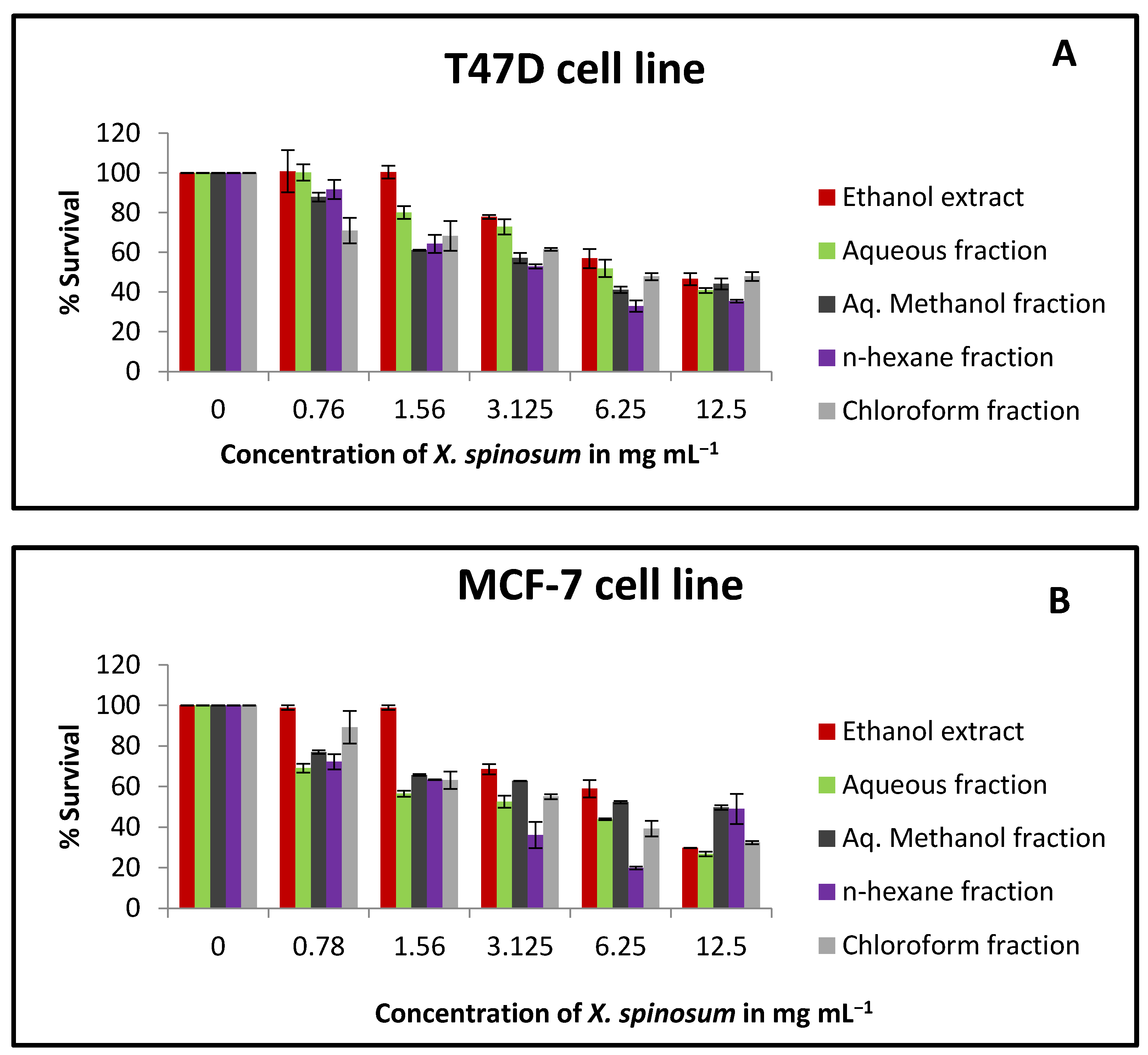
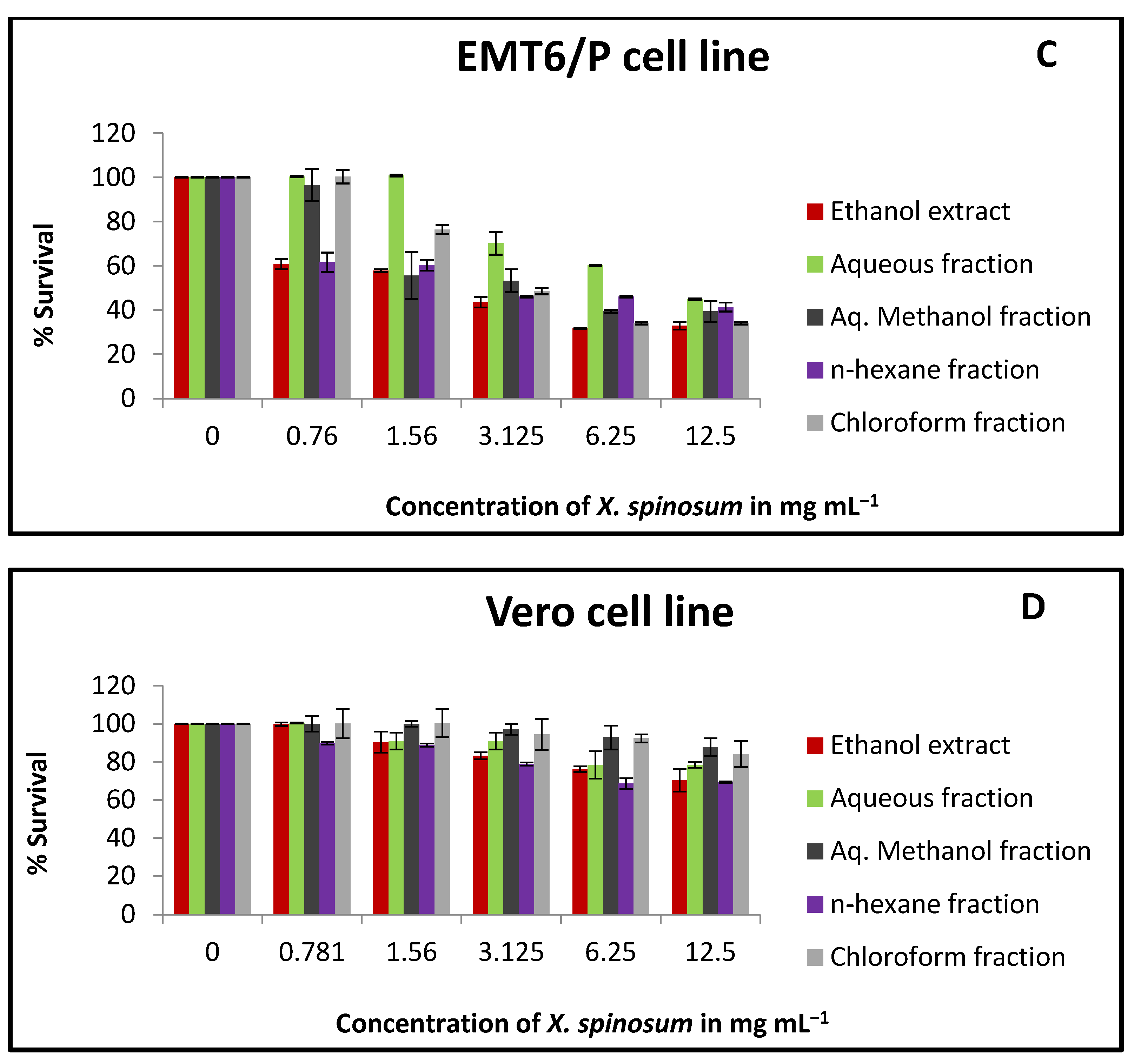
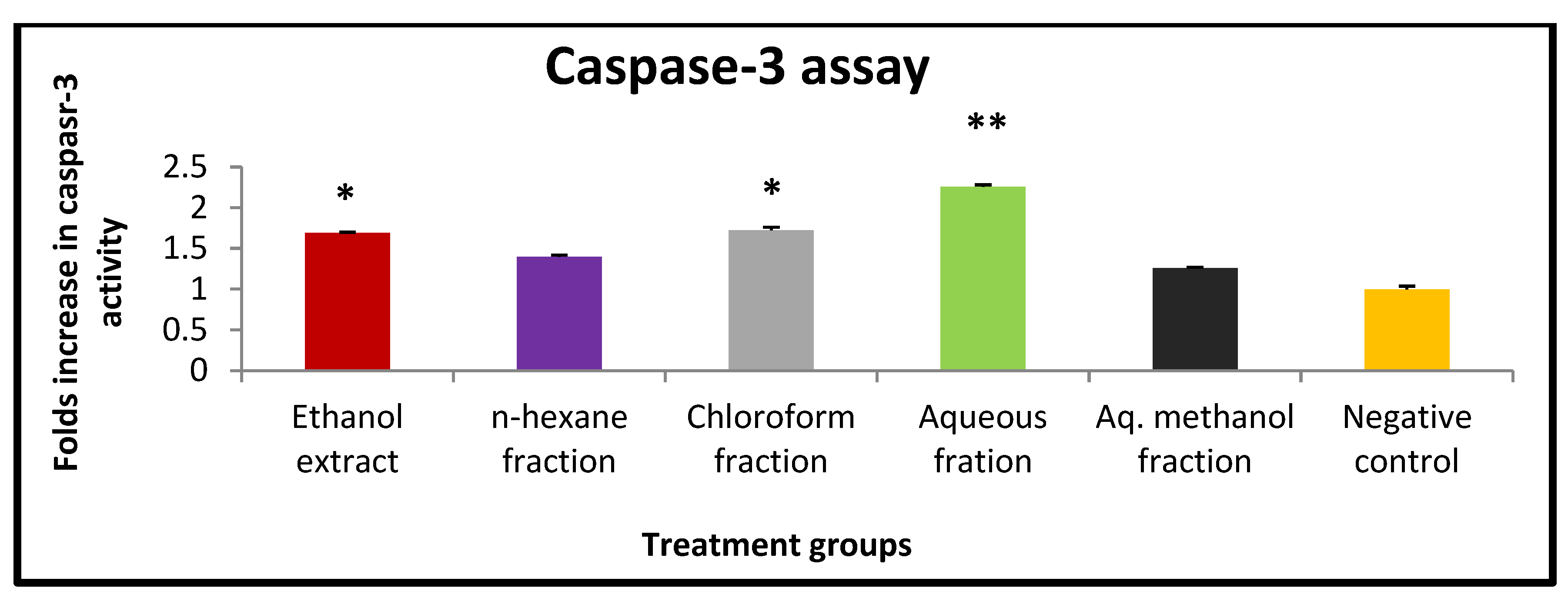
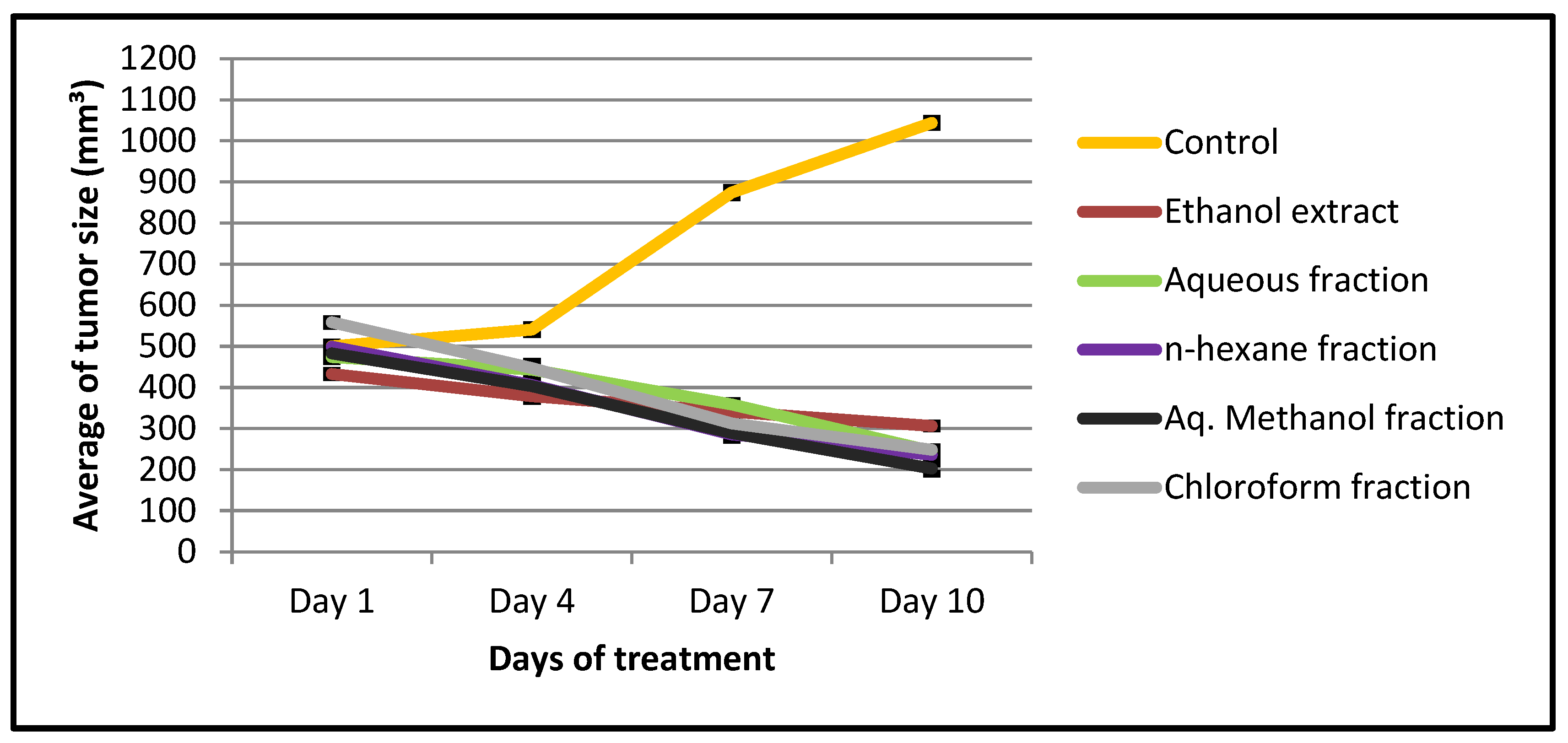
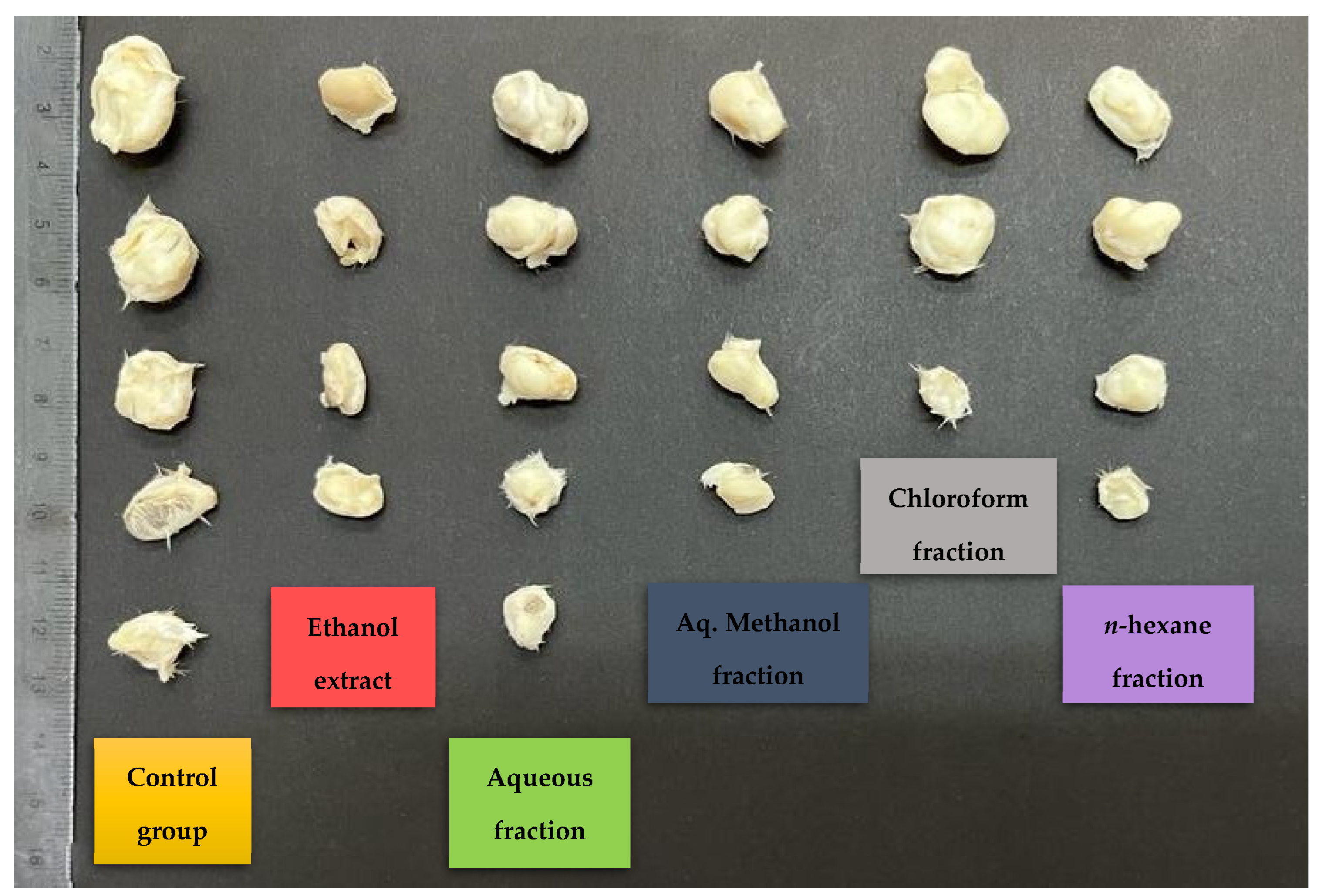
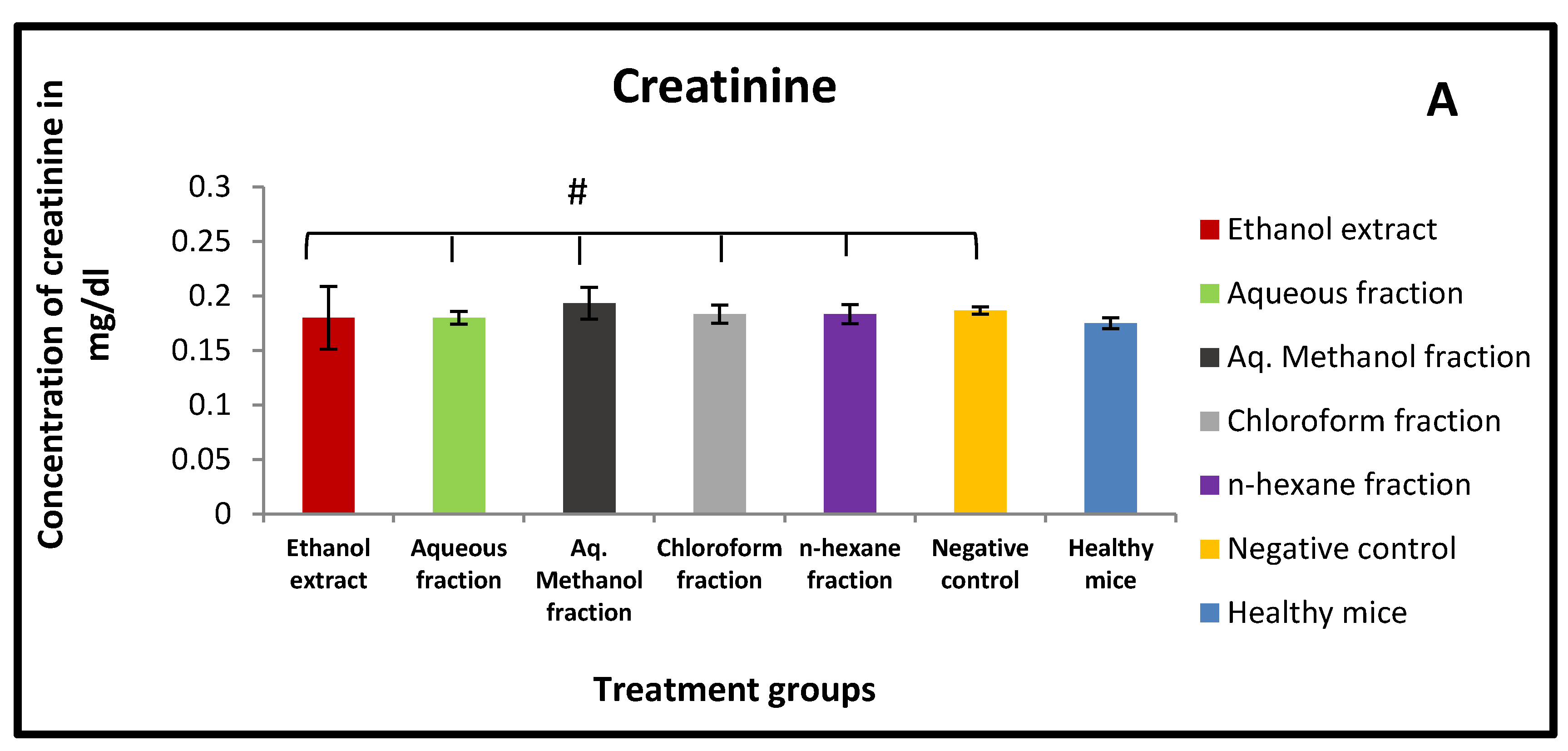
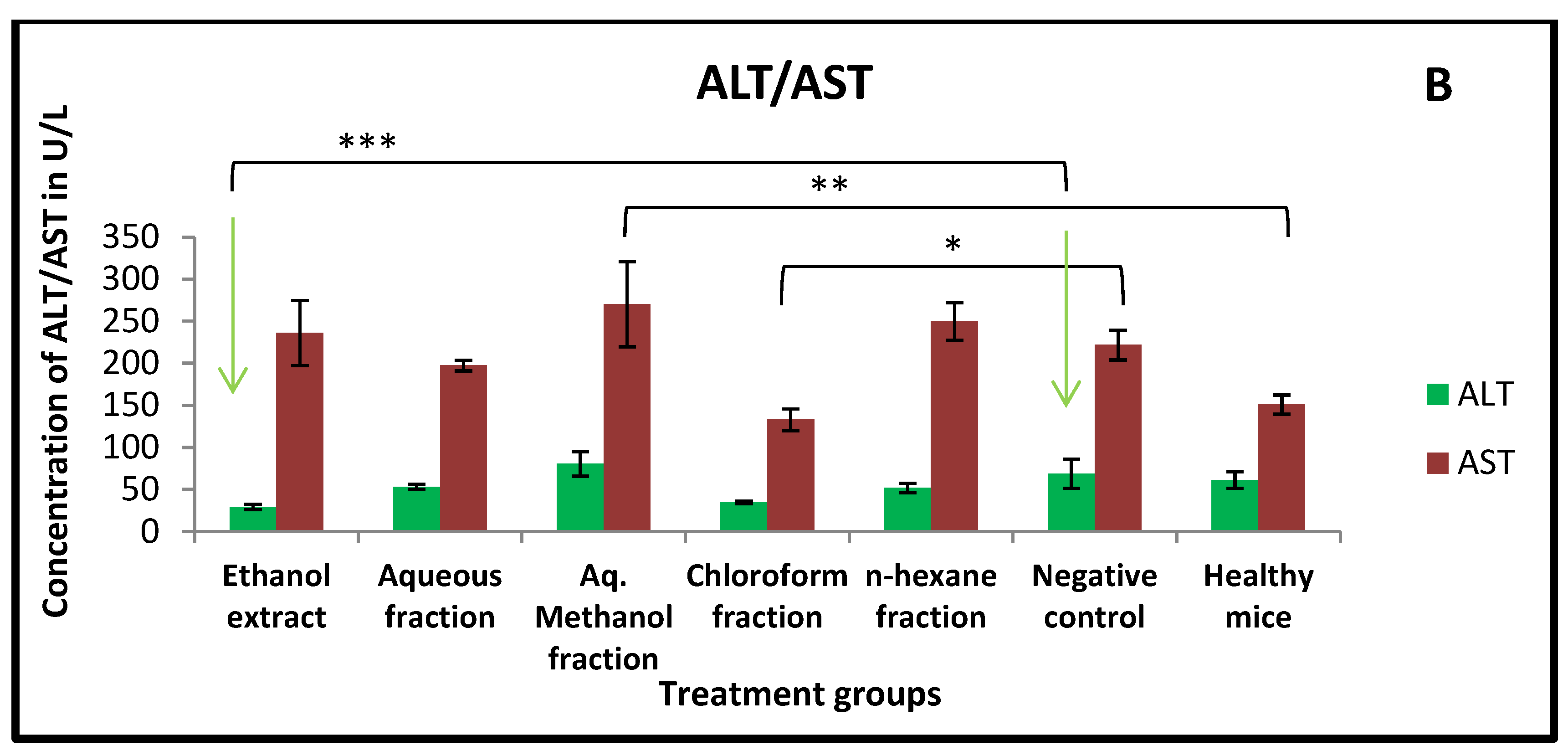
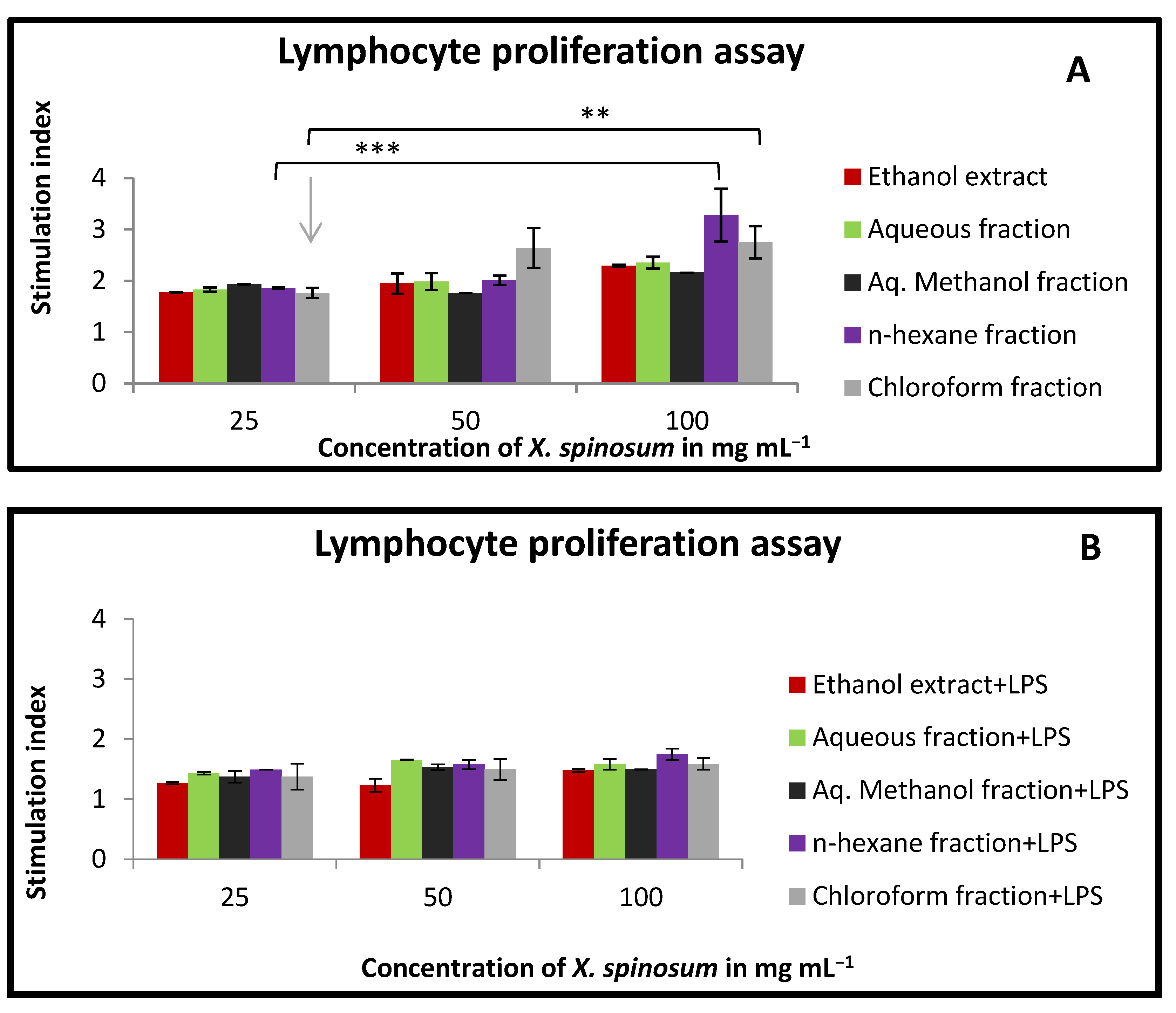
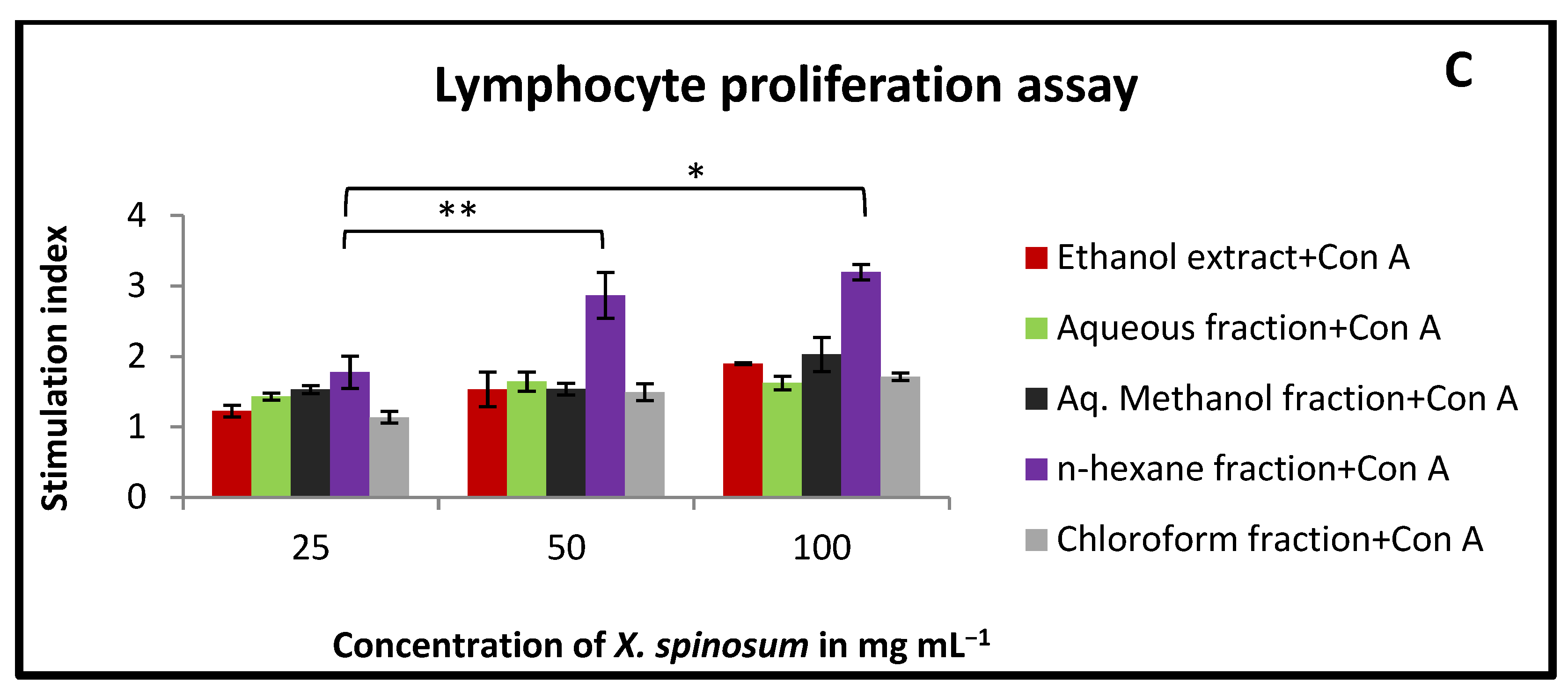
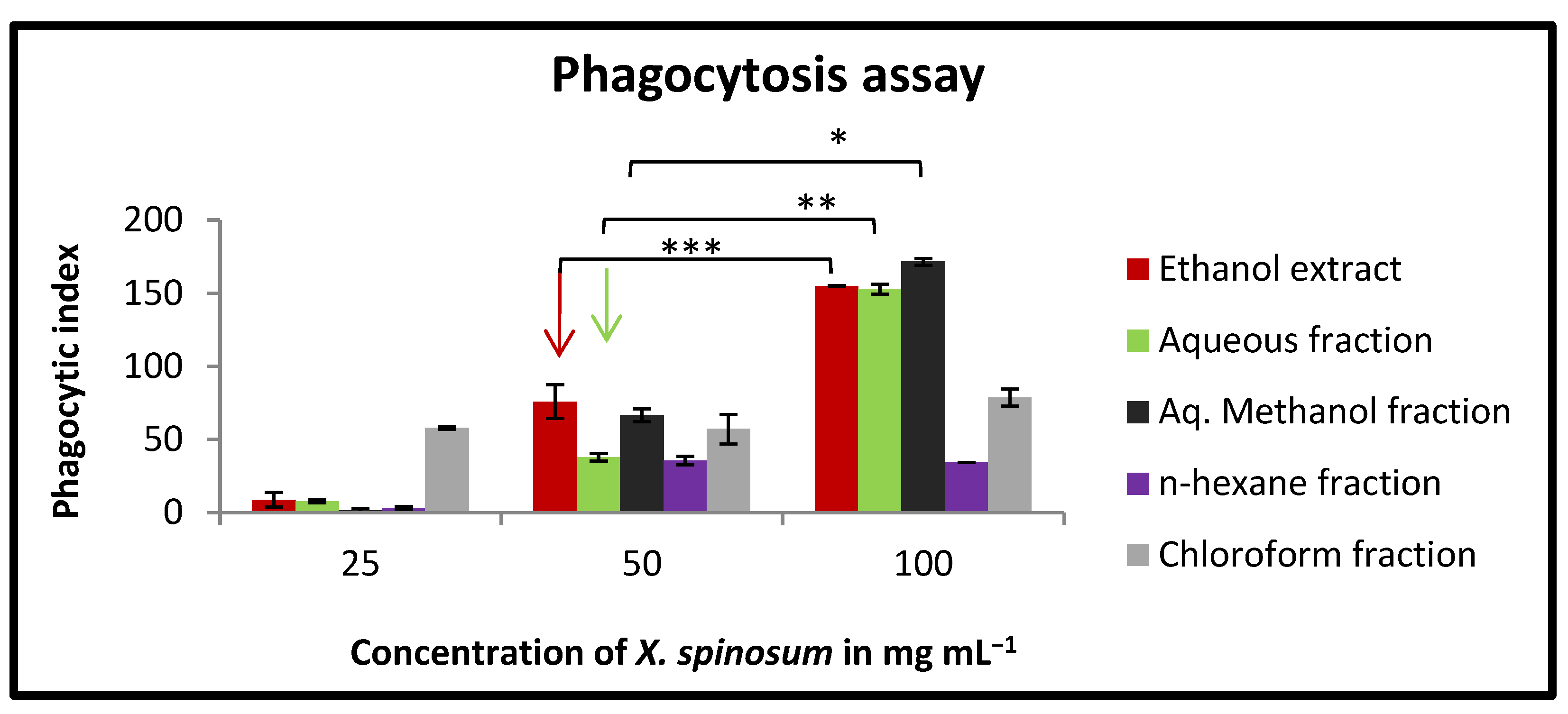
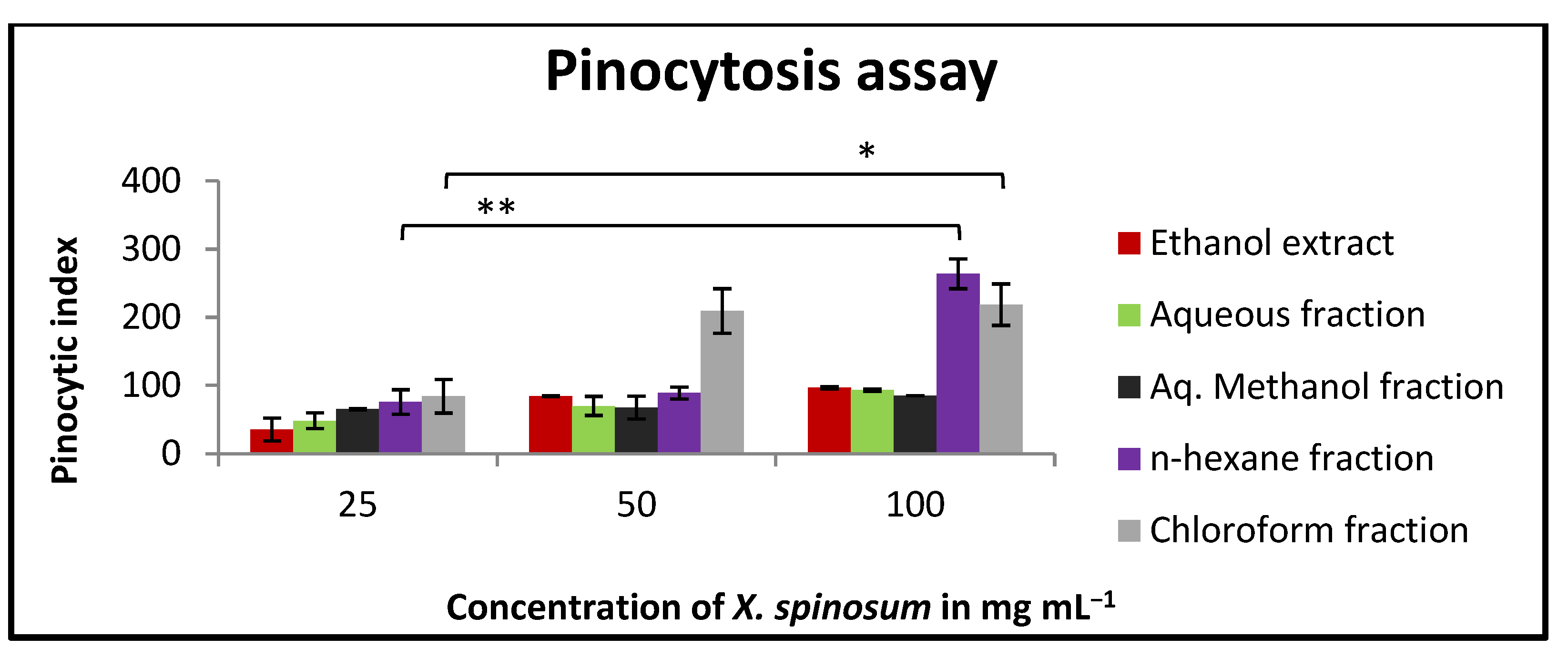
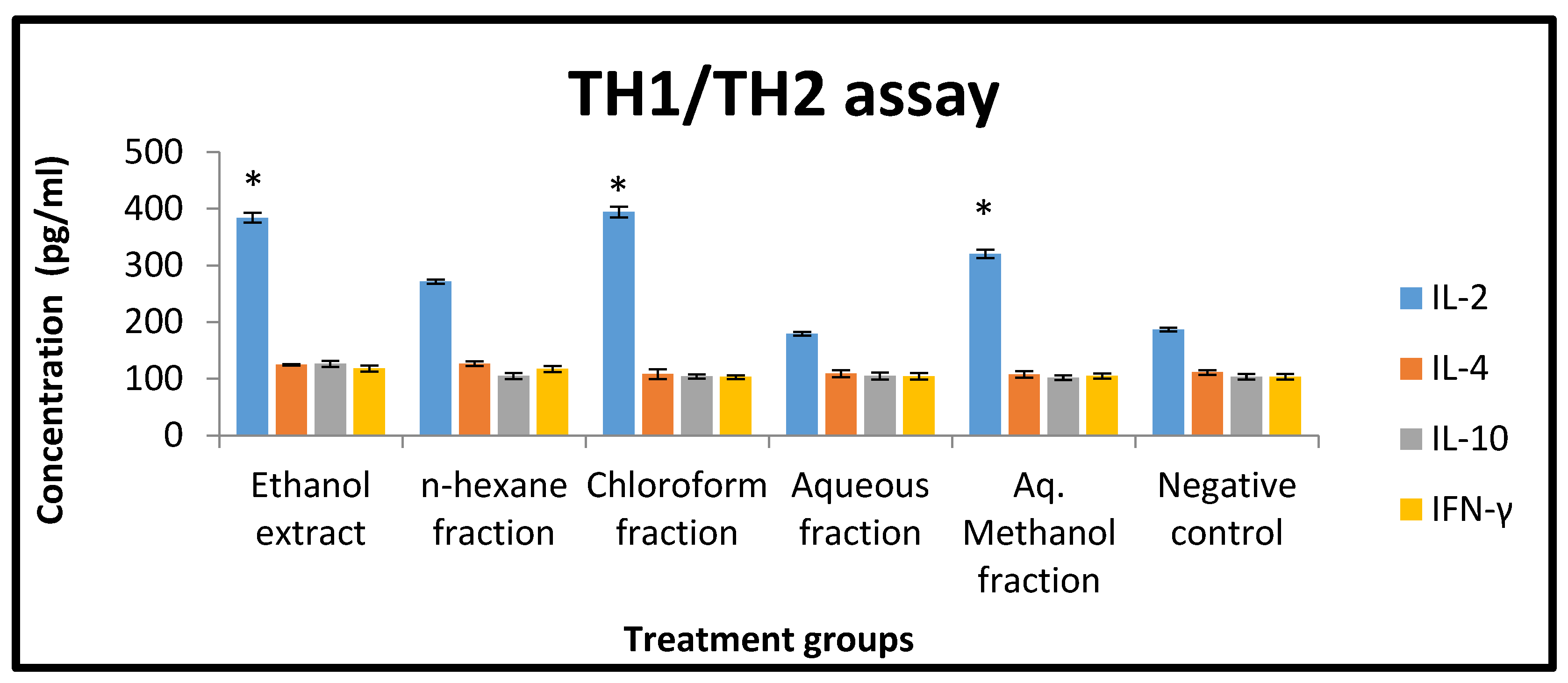
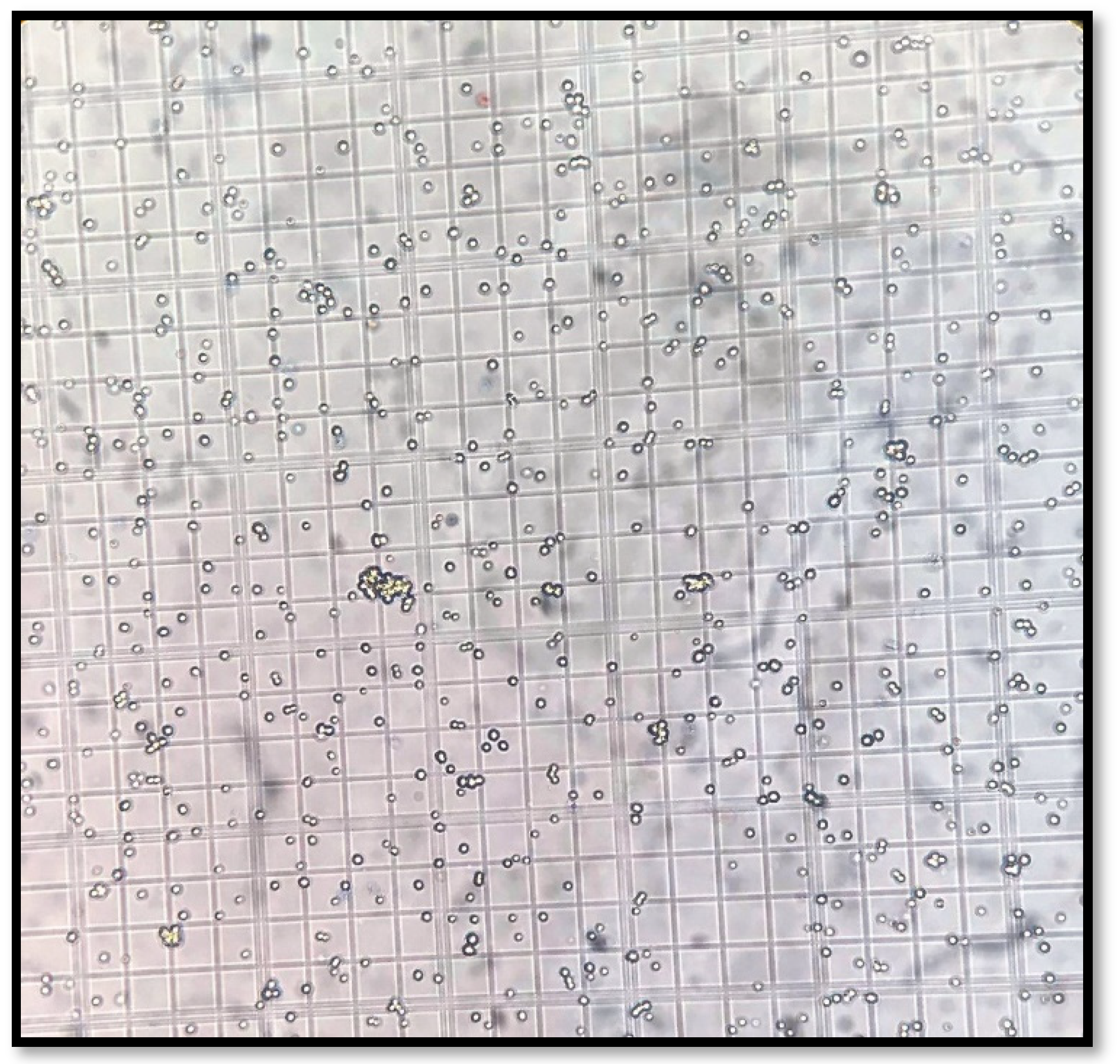
| NO | Compounds | Formula | RT (Retention Time) | Relative % Among Detected Compounds (Ethanol Extract) |
|---|---|---|---|---|
| 1 | 3,5-Dimethoxy-4-hydroxyacetophenone | C10H12O4 | 4.32 | 0.183 |
| 2 | Saponarin | C27H30O15 | 4.98 | 0.668 |
| 3 | Aspalathin | C21H24O11 | 5.27 | 0.148 |
| 4 | Genistin | C21H20O10 | 5.68 | 0.399 |
| 5 | Umbelliferone | C9H6O3 | 6.02 | 0.973 |
| 6 | Naringenin-7-O-glucoside | C21H22O10 | 6.64 | 0.546 |
| 7 | HexA-Apigenin (or Galangin or Genistein) (PUT) | C21H18O11 | 6.76 | 1.224 |
| 8 | Apigenin-7-O-glucoside (Apigetrin) | C21H20O10 | 6.81 | 0.980 |
| 9 | HexA-Chrysoeriol (or Kaempferide) (PUT) | C22H20O12 | 7.08 | 1.244 |
| 10 | 7-Glu Chrysoeriol (NMR) | C22H22O11 | 7.14 | 0.705 |
| 11 | Luteolin | C15H10O6 | 8.65 | 0.195 |
| 12 | Sorbifolin | C16H12O6 | 9.07 | 0.509 |
| 13 | Apigenin | C15H10O5 | 9.93 | 0.696 |
| 14 | Hispidulin | C16H12O6 | 10.35 | 0.506 |
| 15 | Eupatilin | C18H16O7 | 12.59 | 89.824 |
| 16 | Kumatakenin | C17H14O6 | 14.1 | 1.193 |
| NO | Compounds | Formula | RT | Relative % Among Detected Compounds (Chloroform Fraction) |
|---|---|---|---|---|
| 1 | Vanillin | C8H8O3 | 4.1 | 0.083 |
| 2 | (4 or 7) Hydroxy-Coumarin Plus Hydrate | C9H6O3 | 6.01 | 0.081 |
| 3 | HexA-Chrysoeriol (or Kaempferide) (PUT) | C22H20O12 | 7.13 | 0.047 |
| 4 | 7-Glu Chrysoeriol (NMR) | C22H22O11 | 7.2 | 0.050 |
| 5 | Hydrocinnamic acid | C9H10O2 | 7.83 | 0.049 |
| 6 | naringenin | C15H12O5 | 9.52 | 0.157 |
| 7 | 5,6,4′-Trihydroxy-7,3′-dimethoxyflavone | C17H14O7 | 9.63 | 17.767 |
| 8 | Apigenin | C15H10O5 | 9.89 | 0.386 |
| 9 | 6,8-Dimethyl-4-hydroxycoumarin | C11H10O3 | 10.44 | 0.050 |
| 10 | 6,8-Dimethyl-4-hydroxycoumarin | C11H10O3 | 11.51 | 0.040 |
| 11 | 3-Oxocostusic acid | C15H20O3 | 11.9 | 0.045 |
| 12 | Eupatilin | C18H16O7 | 12.49 | 76.839 |
| 13 | Isobavachin | C20H22O4 | 14.01 | 0.042 |
| 14 | Zapotinin | C18H16O6 | 15.67 | 3.966 |
| 15 | Pygenic acid B | C30H48O5 | 18.48 | 0.043 |
| 16 | Glc-Glc-octadecatrienoyl-sn-glycerol (isomer 1) (PUT) | C33H56O14 | 20.27 | 0.078 |
| 17 | Hederagenin | C30H48O4 | 21.49 | 0.063 |
| 18 | Ursolic acid | C30H48O3 | 27.98 | 0.132 |
| 19 | y-Linolenic acid | C18H30O2 | 28.14 | 0.074 |
| NO | Compounds | Formula | RT | Relative % Among Detected Compounds (n-Hexane Fraction) |
|---|---|---|---|---|
| 1 | Acteoside | C29H36O15 | 5.93 | 4.301 |
| 2 | Baicalein | C15H10O5 | 9.81 | 5.670 |
| 3 | 5,6,4′-Trihydroxy-7,3′-dimethoxyflavone | C17H14O7 | 10.49 | 4.510 |
| 4 | Eupatilin | C18H16O7 | 12.39 | 85.517 |
| NO | Compounds | Formula | RT | Relative % Among Detected Compounds (Aq. Methanol Fraction) |
|---|---|---|---|---|
| 1 | Succinic acid | C4H6O4 | 0.96 | 0.771 |
| 2 | Chlorogenic acid | C16H18O9 | 2.02 | 0.279 |
| 3 | 4-Hydroxybenzoic acid | C7H6O3 | 2.38 | 0.331 |
| 4 | 4-Hydroxybenzoic acid | C7H6O3 | 2.53 | 0.462 |
| 5 | Saponarin | C27H30O15 | 4.56 | 0.732 |
| 6 | Apiin | C26H28O14 | 4.83 | 31.047 |
| 7 | Benzoic acid | C7H6O2 | 5.45 | 0.271 |
| 8 | 6,7,3′,4′-Tetrahydroxyflavanone | C15H12O6 | 5.47 | 1.898 |
| 9 | 3-Hydroxy-4-methoxycinnamic acid (isoferulic acid) | C10H10O4 | 5.47 | 3.732 |
| 10 | Salicylic acid | C7H6O3 | 5.78 | 0.331 |
| 11 | Acteoside | C29H36O15 | 5.92 | 48.386 |
| 12 | Hesperidin | C28H34O15 | 6.1 | 0.336 |
| 13 | Naringenin-7-O-glucoside | C21H22O10 | 6.51 | 1.977 |
| 14 | Naringin | C27H32O14 | 6.61 | 0.367 |
| 15 | 3′,4′,7-Trihydroxyisoflavone | C15H10O5 | 6.78 | 0.582 |
| 16 | HexA-Apigenin (or Galangin or Genistein) (PUT) | C21H18O11 | 6.79 | 3.525 |
| 17 | HexA-Chrysoeriol (or Kaempferide) (PUT) | C22H20O12 | 7.11 | 4.708 |
| 18 | Baicalein | C15H10O5 | 9.82 | 0.256 |
| NO | Compounds | Formula | RT | Relative % Among Detected Compounds (Aqueous Fraction) |
|---|---|---|---|---|
| 1 | 2,5-Dihydroxybenzoic acid | C7H6O4 | 1.7 | 0.102 |
| 2 | 4-Hydroxybenzoic acid | C7H6O3 | 2.52 | 1.174 |
| 3 | Chlorogenic acid | C16H18O9 | 2.92 | 1.662 |
| 4 | Umbelliferone | C9H6O3 | 3.93 | 0.546 |
| 5 | Apiin | C26H28O14 | 4.89 | 39.604 |
| 6 | Ferulic acid (trans) | C10H10O4 | 5.11 | 0.202 |
| 7 | Benzoic acid | C7H6O2 | 5.29 | 0.093 |
| 8 | Scutellarein-7-glucuronide | C21H18O12 | 5.86 | 5.724 |
| 9 | 3-O-Neohesperidoside Kaempferol (NMR) | C27H30O15 | 6.14 | 0.092 |
| 10 | 3′,4′,7-Trihydroxyisoflavone | C15H10O5 | 6.82 | 0.280 |
| 11 | HexA-Apigenin (or Galangin or Genistein) (PUT) | C21H18O11 | 6.82 | 19.858 |
| 12 | 4-Methylumbelliferone | C10H8O3 | 7 | 0.698 |
| 13 | HexA-Chrysoeriol (or Kaempferide) (PUT) | C22H20O12 | 7.12 | 19.034 |
| 14 | Naringin | C27H32O14 | 7.28 | 0.186 |
| 15 | Luteolin | C15H10O6 | 8.58 | 0.124 |
| 16 | 5,6,4′-Trihydroxy-7,3′-dimethoxyflavone | C17H14O7 | 9.59 | 6.236 |
| 17 | Apigenin | C15H10O5 | 9.88 | 0.565 |
| 18 | Eupatilin | C18H16O7 | 9.88 | 2.810 |
| X. spinosum Extract and Fractions | MCF-7 IC₅₀ (mg mL−1) ± SEM | T47D IC₅₀ (mg mL−1) ± SEM | EMT6/P IC₅₀ (mg mL−1) ± SEM | Vero IC₅₀ (mg mL−1) ± SEM |
|---|---|---|---|---|
| Ethanol extract | 9.3 ± 0.25 | 12.82 ± 0.24 | 2.57 ± 0.24 | >100 |
| Chloroform fraction | 7.09 ± 2.33 | 9.94 ± 1.23 | 7.59 ± 0.11 | >100 |
| Aqueous fraction | 4.78 ± 0.24 | 10.83 ± 0.02 | 11.83 ± 0.02 | >100 |
| Aq. Methanol fraction | 10.68 ± 0.25 | 8.22 ± 0.62 | 8.1 ± 0.85 | >100 |
| n-hexane fraction | 4.29 ± 2.95 | 6.59 ± 0.5 | 5.52 ± 1.16 | >100 |
| Groups (n = 6) | Dose (mg/kg) | Dose Difference (a) | Ethanol Extract | Aqueous & aq. Methanol Fractions | ||||
|---|---|---|---|---|---|---|---|---|
| No. of Mortality | Mean Mortality (b) | Probit (a × b) | No. of Mortality | Mean Mortality (b) | Probit (a × b) | |||
| 1 | 500 | 0 | 0 | 0 | 0 | 0 | 0 | 0 |
| 2 | 4000 | 3500 | 2 | 1 | 3500 | 1 | 0.5 | 1750 |
| 3 | 7500 | 3500 | 3 | 2.5 | 8750 | 3 | 2 | 7000 |
| Groups (n = 6) | Dose (mg/kg) | Dose Difference (a) | Chloroform Fraction | n-Hexane Fraction | ||||
|---|---|---|---|---|---|---|---|---|
| No. of Mortality | Mean Mortality (b) | Probit (a × b) | No. of Mortality | Mean Mortality (b) | Probit (a × b) | |||
| 1 | 100 | 0 | 0 | 0 | 0 | 0 | 0 | 0 |
| 2 | 300 | 200 | 1 | 0.5 | 100 | 2 | 1 | 200 |
| 3 | 500 | 200 | 3 | 2 | 400 | 4 | 3 | 600 |
| Treatment Groups (n = 7) | Initial Tumor Size (mm3) ± SEM | Final Tumor Size (mm3) ± SEM | % Change in Tumor Size | % Of mice with no Detectable Tumor | Number of Deaths | Average Tumor Weight (g) |
|---|---|---|---|---|---|---|
| Negative control | 500.5 ± 8.8 | 1043.8 ± 11.1 | 108.5 | 22.2% | 1 | 0.73 |
| X. spinosum ethanol extract | 433 ± 7.4 | 306.44 ± 9.8 | −29.2 | 42.8%% | 0 | 0.23 |
| X. spinosum aqueous fraction | 473.9 ± 8.1 | 245.2 ± 12.1 | −48.2 | 28.5% | 0 | 0.54 |
| X. spinosum Aq. Methanol fraction | 482.90 ± 6.4 | 202.6 ± 9.2 | −58.0 | 42.8% | 0 | 0.29 |
| X. spinosum chloroform fraction | 558.6 ± 8.3 | 248.5 ± 10.9 | −55.5 | 57.1% | 0 | 0.39 |
| X. spinosum n-hexane fraction | 499.2 ± 11.5 | 236.1 ± 13.9 | −52.7 | 42.8% | 0 | 0.24 |
Publisher’s Note: MDPI stays neutral with regard to jurisdictional claims in published maps and institutional affiliations. |
© 2022 by the authors. Licensee MDPI, Basel, Switzerland. This article is an open access article distributed under the terms and conditions of the Creative Commons Attribution (CC BY) license (https://creativecommons.org/licenses/by/4.0/).
Share and Cite
Al Kury, L.T.; Taha, Z.; Mahmod, A.I.; Talib, W.H. Xanthium spinosum L. Extracts Inhibit Breast Cancer in Mice by Apoptosis Induction and Immune System Modulation. Pharmaceuticals 2022, 15, 1504. https://doi.org/10.3390/ph15121504
Al Kury LT, Taha Z, Mahmod AI, Talib WH. Xanthium spinosum L. Extracts Inhibit Breast Cancer in Mice by Apoptosis Induction and Immune System Modulation. Pharmaceuticals. 2022; 15(12):1504. https://doi.org/10.3390/ph15121504
Chicago/Turabian StyleAl Kury, Lina T., Zainab Taha, Asma Ismail Mahmod, and Wamidh H. Talib. 2022. "Xanthium spinosum L. Extracts Inhibit Breast Cancer in Mice by Apoptosis Induction and Immune System Modulation" Pharmaceuticals 15, no. 12: 1504. https://doi.org/10.3390/ph15121504
APA StyleAl Kury, L. T., Taha, Z., Mahmod, A. I., & Talib, W. H. (2022). Xanthium spinosum L. Extracts Inhibit Breast Cancer in Mice by Apoptosis Induction and Immune System Modulation. Pharmaceuticals, 15(12), 1504. https://doi.org/10.3390/ph15121504







